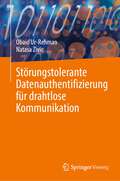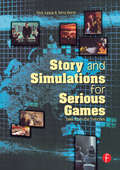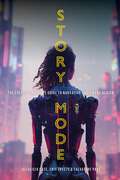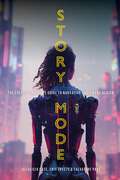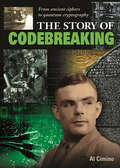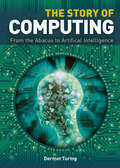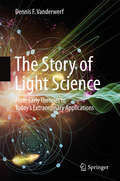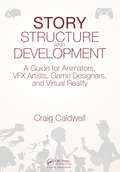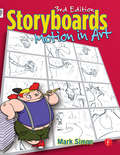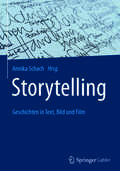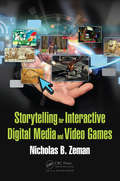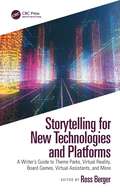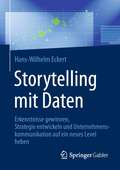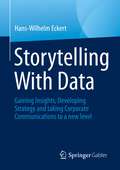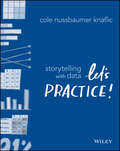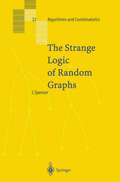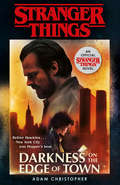- Table View
- List View
Storminess and Environmental Change: Climate Forcing and Responses in the Mediterranean Region (Advances in Natural and Technological Hazards Research #39)
by Nazzareno Diodato Gianni BellocchiThis book describes recent developments in the modeling of hydro-climatological processes in time and space. The topic brings together a wide range of disciplines, such as climatology, hydrology, geomorphology and ecology, with examples of problems and related modeling approaches. Parsimonious hydro-climatological models hold the potential to simulate the combined effects of rainfall intensity and distribution patterns in the absence of precipitation records for short time intervals (e.g. daily to sub-hourly) and over large areas (e.g. regional to continental). In this book, we show how the principle of parsimony can be followed without sacrificing depth in seeking to understand a variety of landscape and surface processes that include hydrologic phenomena. Geographically speaking, the focus of the book is on Mediterranean environments. In this region, which is characterized by a complex morphology, soil erosion by water is a major cause of landscape degradation and the fragility of ecosystems is abundantly documented. By exploring interactions between erosive storms and land with the help of modeling solutions created at a variety of scales, the book investigates in detail the climatic implications for the Mediterranean landscape in an effort to bridge historical and contemporary research, which makes it unique in its approach.The book provides a valuable resource for environmental scientists, while also providing an important basis for graduate and postgraduate students interested in research on hydrological cycles and environmental changes.
Störungstolerante Datenauthentifizierung für drahtlose Kommunikation
by Obaid Ur-Rehman Natasa ZivicDieses Buch gibt einen Einblick in die Herausforderungen der Datenauthentifizierung über drahtlose Kommunikationskanäle. Die Autoren gehen davon aus, dass die etablierten Standard-Authentifizierungsmechanismen nicht ausreichen, um Daten wie Sprache, Bilder und Videos über drahtlose Kanäle zu authentifizieren, da die drahtlose Kommunikation durch zahlreiche Störungen gekennzeichnet ist. Die Autoren schlagen neue Mechanismen vor, die auf so genannten Soft-Authentifizierungsalgorithmen basieren, die einige Änderungen an den zu schützenden Daten tolerieren. Die Autoren erklären, dass das Ziel dieser Algorithmen darin besteht, tolerant gegenüber inhaltlichen Änderungen auf Grund von Übertragungsfehler zu sein, aber dennoch in der Lage zu sein, Fälschungen zu erkennen. Ein weiterer Vorteil der Soft-Authentifizierungsalgorithmen besteht darin, dass sie in der Lage sind, die veränderten Stellen zu identifizieren und sie nach Möglichkeit zu korrigieren. Die Autoren zeigen, wie man dies erreicht, indem man die Datenmerkmale mit Hilfe von fehlerkorrigierenden Codes schützt. · Erörtert Methoden zur Authentifizierung von Daten (insbesondere von Bildern) bei Übertragungsstörungen, die bei der drahtlosen Kommunikation auftreten; · Stellt eine neue Klasse von Soft-Authentifizierungsmethoden vor, die anstelle der üblichen Hard-Authentifizierungsmethoden verwendet werden, um geringfügige Änderungen der Bilddaten zu tolerieren; · Verfügt über Authentifizierungsmethoden, die auf der Verwendung von Authentifizierungscodes und digitalen Wasserzeichen basieren
Story and Simulations for Serious Games: Tales from the Trenches
by Nick Iuppa Terry BorstHow to create a simulation where participants have a sense of freedom and personal control while still maintaining the structure necessary for an effective story is a difficult task indeed. This book examines how to create an engaging, effective story (necessary to teach participants), while relating practical considerations of building a simulation. It also looks at stories as classic ways of teaching and gathering knowledge and considers other theories of interactive narrative design such as synthetic story creation and management and participant-generated story experiences. It also discusses enabling technologies in artificial intelligence, synthetic characters design and development, speech recognition technology, 3D modelling, and the future of story-driven games. Story Driven Simulations reviews the existing efforts in this field as well as focusing on the recent efforts of Paramount Pictures and The Institute for Creative Technologies at the University of Southern California, where this expert author team created successful simulations for the U.S. Army, Department of Defense, as well as other educational simulations.
Story and Simulations for Serious Games: Tales from the Trenches
by Nick Iuppa Terry BorstHow to create a simulation where participants have a sense of freedom and personal control while still maintaining the structure necessary for an effective story is a difficult task indeed. This book examines how to create an engaging, effective story (necessary to teach participants), while relating practical considerations of building a simulation. It also looks at stories as classic ways of teaching and gathering knowledge and considers other theories of interactive narrative design such as synthetic story creation and management and participant-generated story experiences. It also discusses enabling technologies in artificial intelligence, synthetic characters design and development, speech recognition technology, 3D modelling, and the future of story-driven games. Story Driven Simulations reviews the existing efforts in this field as well as focusing on the recent efforts of Paramount Pictures and The Institute for Creative Technologies at the University of Southern California, where this expert author team created successful simulations for the U.S. Army, Department of Defense, as well as other educational simulations.
Story Mode: The Creative Writer's Guide to Narrative Video Game Design
by Professor Julialicia Case Professor Eric Freeze Professor Salvatore PaneAgainst the backdrop of a hyper-competitive AAA industry and the perception that it is a world reserved for top programmers and hard-core 'gamers', Story Mode offers an accessible entry-point for all into writing and designing complex and emotionally affecting narrative video games. The first textbook to combine game design with creative writing techniques, this much-needed resource makes the skills necessary to consume and create digital and multi-modal stories attainable and fun. Appealing to the growing calls for greater inclusivity and access to this important contemporary apparatus of expression, this book offers low-cost, accessible tools and instruction that bridge the knowledge gap for creative writers, showing them how they can merge their skill-set with the fundamentals of game creation and empowering them to produce their own games which push stories beyond the page and the written word. Broken down into 4 sections to best orientate writers from any technological background to the strategies of game production, this book offers: - Contextual and introductory chapters exploring the history and variety of various game genres. - Discussions of how traditional creative writing approaches to character, plot, world-building and dialogue can be utilised in game writing. - An in-depth overview of game studies concepts such as game construction, interactivity, audience engagement, empathy, real-world change and representation that orientate writers to approach games from the perspective of a designer. - A whole section on the practical elements of work-shopping, tools, collaborative writing as well as extended exercises guiding readers through long-term, collaborative, game-centred projects using suites and tools like Twine, Audacity, Bitsy, and GameMaker. Featuring detailed craft lessons, hands-on exercises and case studies, this is the ultimate guide for creative writers wanting to diversify into writing for interactive, digital and contemporary modes of storytelling. Designed not to lay out a roadmap to a successful career in the games industry but to empower writers to experiment in a medium previously regarded as exclusive, this book demystifies the process behind creating video games, orienting readers to a wide range of new possible forms and inspiring them to challenge mainstream notions of what video games can be and become.
Story Mode: The Creative Writer's Guide to Narrative Video Game Design
by Professor Julialicia Case Professor Eric Freeze Professor Salvatore PaneAgainst the backdrop of a hyper-competitive AAA industry and the perception that it is a world reserved for top programmers and hard-core 'gamers', Story Mode offers an accessible entry-point for all into writing and designing complex and emotionally affecting narrative video games. The first textbook to combine game design with creative writing techniques, this much-needed resource makes the skills necessary to consume and create digital and multi-modal stories attainable and fun. Appealing to the growing calls for greater inclusivity and access to this important contemporary apparatus of expression, this book offers low-cost, accessible tools and instruction that bridge the knowledge gap for creative writers, showing them how they can merge their skill-set with the fundamentals of game creation and empowering them to produce their own games which push stories beyond the page and the written word. Broken down into 4 sections to best orientate writers from any technological background to the strategies of game production, this book offers: - Contextual and introductory chapters exploring the history and variety of various game genres. - Discussions of how traditional creative writing approaches to character, plot, world-building and dialogue can be utilised in game writing. - An in-depth overview of game studies concepts such as game construction, interactivity, audience engagement, empathy, real-world change and representation that orientate writers to approach games from the perspective of a designer. - A whole section on the practical elements of work-shopping, tools, collaborative writing as well as extended exercises guiding readers through long-term, collaborative, game-centred projects using suites and tools like Twine, Audacity, Bitsy, and GameMaker. Featuring detailed craft lessons, hands-on exercises and case studies, this is the ultimate guide for creative writers wanting to diversify into writing for interactive, digital and contemporary modes of storytelling. Designed not to lay out a roadmap to a successful career in the games industry but to empower writers to experiment in a medium previously regarded as exclusive, this book demystifies the process behind creating video games, orienting readers to a wide range of new possible forms and inspiring them to challenge mainstream notions of what video games can be and become.
The Story of Codebreaking (The Story of)
by Al CiminoTo break a code, you have to put yourself in the mind of your enemy in order to probe the strengths and weaknesses of their systems. It's a game of bluff and doublebluff. The Story of Codebreaking describes undercover operations, power struggles, secret alliances, and brilliant feats of teamwork. Those who invent codes and those who break them are remarkable, indefatigable characters. Find out how Mary Queen of Scots smuggled cryptic messages to her accomplices when she was plotting against her cousin Elizabeth I, or discover the methods used by codebreakers during World Wars I and II, most significantly those who cracked Enigma and intercepted Japanese naval messages prior to Pearl Harbor. The sheer doggedness of those who unraveled the Enigma code is thought to have shortened World War II by almost two years. Topics include: • Ancient ciphers and the art of encoding • Early spies, subterfuge and skytales • The making and breaking of Enigma • Japanese naval codes in World War II • Cold War cryptography
The Story of Computing (The Story of)
by Sir John Dermot TuringToday computers shape every aspect of our lives. In our pockets, we carry mobile phones with computing power that was unimaginable just 50 years ago. Many industries are embracing the promises - and the risks - of artificial intelligence. The world is changing faster than ever, and computing is at the heart of technological development. Dermot Turing explores the history of this rapidly evolving technology, from the Charles Babbage and his experiments with steam powered calculators to the computerised Go champion, AlphaGo. Featuring wonderful, full-colour images which illustrate this history, The Story of Computing is the essential guide to a subject that none of us can ignore. Topics include: • The birth of the computer • Codebreaking in World War II • Innovations in hardware and software • Artificial intelligence • The internet • The challenges of cybersecurity.
The Story of Light Science: From Early Theories to Today's Extraordinary Applications
by Dennis F. VanderwerfThis book traces the evolution of our understanding and utilization of light from classical antiquity and the early thoughts of Pythagoras to the present time. From the earliest recorded theories and experiments to the latest applications in photonic communication and computation, the ways in which light has been put to use are numerous and astounding. Indeed, some of the latest advances in light science are in fields that until recently belonged to the realm of science fiction. The author, writing for an audience of both students and other scientifically interested readers, describes fundamental investigations of the nature of light and ongoing methods to measure its speed as well as the emergence of the wave theory of light and the complementary photon theory. The importance of light in the theory of relativity is discussed as is the development of electrically-driven light sources and lasers. The information here covers the range of weak single-photon light sources to super-high power lasers and synchrotron light sources. Many cutting-edge topics are also introduced, including entanglement-based quantum communication through optical fibers and free space, quantum teleportation, and quantum computing. The nature and use of "squeezed light" - e.g. for gravitational wave detection - is another fascinating excursion, as is the topic of fabricated metamaterials, as used to create invisibility cloaks. Here the reader also learns about the realization of extremely slow speed and time-reversed light. The theories, experiments, and applications described in this book are, whenever possible, derived from original references. The many annotated drawings and level of detail make clear the goals, procedures, and conclusions of the original investigators. Where they are required, all specialist terms and mathematical symbols are defined and explained.The final part of the book covers light experiments in the free space of the cosmos, and also speculates about scenarios for the cosmological origins of light and the expected fate of the photon in a dying universe.
Story Structure and Development: A Guide for Animators, VFX Artists, Game Designers, and Virtual Reality
by Craig CaldwellProfessor Craig Caldwell’s Story Structure and Development offers a clear approach to the essentials of story. It lays out the fundamental elements, principles, and structure for animators, designers, and artists so they can incorporate these concepts in their work. As a practical guide it includes extensive insights and advice from industry professionals. Readers will learn the universal patterns of story and narrative used in today’s movies, animation, games, and VR. With over 200 colorful images, this book has been designed for visual learners, and is organized to provide access to story concepts for the screen media professional and student. Readers will discover the story fundamentals referred to by every director and producer when they say "It’s all about story".
Story Structure and Development: A Guide for Animators, VFX Artists, Game Designers, and Virtual Reality
by Craig CaldwellProfessor Craig Caldwell’s Story Structure and Development offers a clear approach to the essentials of story. It lays out the fundamental elements, principles, and structure for animators, designers, and artists so they can incorporate these concepts in their work. As a practical guide it includes extensive insights and advice from industry professionals. Readers will learn the universal patterns of story and narrative used in today’s movies, animation, games, and VR. With over 200 colorful images, this book has been designed for visual learners, and is organized to provide access to story concepts for the screen media professional and student. Readers will discover the story fundamentals referred to by every director and producer when they say "It’s all about story". Key Features Consolidates into one text universal story structure used across the digital media industry Includes enormous visuals that illustrate and reinforce concepts for visual learners Organizes content for faculty to use sections in a non-linear manner Includes chapter objectives, review questions, and key terms to guide the reader
Storyboards: Motion In Art
by Mark A. SimonAmong the most useful tools in the production of any TV show or film is the storyboard, which is the visual blueprint of a project before it is shot. The director's vision is illustrated in the manner of a comic strip and handed on to the crew for purposes of budgeting, design, and communication.Storyboards: Motion in Art 3/e is an in depth look at the production and business of storyboards. Using exercises, real-life examples of working in the entertainment industry, interviews with people in the industry, and sample storyboard drawing, this book will teach you how to :* Develop and Improve your boards* Work with directors* Develop your resume and your portfolio* Market your talent* Create and improve a storyboard using computersPacked full of practical industry information and examples, this book will help the reader improve their skills to either land their first assignment or advance their career.
Storyboards: Motion In Art
by Mark A. SimonAmong the most useful tools in the production of any TV show or film is the storyboard, which is the visual blueprint of a project before it is shot. The director's vision is illustrated in the manner of a comic strip and handed on to the crew for purposes of budgeting, design, and communication.Storyboards: Motion in Art 3/e is an in depth look at the production and business of storyboards. Using exercises, real-life examples of working in the entertainment industry, interviews with people in the industry, and sample storyboard drawing, this book will teach you how to :* Develop and Improve your boards* Work with directors* Develop your resume and your portfolio* Market your talent* Create and improve a storyboard using computersPacked full of practical industry information and examples, this book will help the reader improve their skills to either land their first assignment or advance their career.
Storytelling: Geschichten in Text, Bild und Film
by Annika SchachDieses Buch beleuchtet das Trendthema Storytelling aus unterschiedlichen Perspektiven - von der narrativen Reportage im Journalismus über Story-Elemente in der Fotografie, der Mode und im Produktdesign, dem inszenierten Erlebnis in der digitalen Welt bis hin zum strategischen Einsatz von Corporate Storys in der externen und internen Unternehmenskommunikation. Die Arbeit mit Geschichten in der Kommunikation ist zwar nicht neu, der strategische Einsatz zur Vermittlung von bestimmten Inhalten und Botschaften, das Storytelling, beschäftigt jedoch aktuell diverse Disziplinen. Die Auseinandersetzung mit dieser Technik ist bereits vom Kern her interdisziplinär, denn Geschichten können in Text, Bild, Ton oder im Film erzählt werden. So umfangreich die praxisbezogene Beschäftigung mit dem Themenbereich ist, so spärlich ist der fächerübergreifende Diskurs, durch den Erkenntnisse aus den unterschiedlichen Disziplinen zusammengeführt, kontrastiert und gewinnbringend diskutiert werden können. Diese Lücke schließt dieses Buch.
Storytelling for Interactive Digital Media and Video Games
by Nicholas B. ZemanThe evolution of story-telling is as old as the human race; from the beginning, when our ancestors first gathered around a campfire to share wondrous tales through oral traditions, to today, with information and stories being shared through waves and filling screens with words and images. Stories have always surrounded us, and united us in ways other disciplines can't. Storytelling for Interactive Digital Media and Video Games lays out the construct of the story, and how it can be manipulated by the storyteller through sound, video, lighting, graphics, and color. This book is the perfect guide to aspiring storytellers as it illustrates the different manner of how and why stories are told, and how to make them "interactive." Storytelling features heavy game development as a method of storytelling and delivery, and how to develop compelling plots, characters, settings, and actions inside a game. The concept of digital storytelling will be explored, and how this differs from previous incarnations of mediums for stories Key Features: Explores the necessary elements of a story (setting, character, events, sequence, and perspective) and how they affect the viewer of the story Discusses media and its role in storytelling, including images, art, sound, video, and animation Explores the effect of interactivity on the story, such as contest TV, web-based storytelling, kiosks, and games Shows the different types of story themes in gaming and how they are interwoven Describes how to make games engaging and rewarding intrinsically and extrinsically
Storytelling for Interactive Digital Media and Video Games
by Nicholas B. ZemanThe evolution of story-telling is as old as the human race; from the beginning, when our ancestors first gathered around a campfire to share wondrous tales through oral traditions, to today, with information and stories being shared through waves and filling screens with words and images. Stories have always surrounded us, and united us in ways other disciplines can't. Storytelling for Interactive Digital Media and Video Games lays out the construct of the story, and how it can be manipulated by the storyteller through sound, video, lighting, graphics, and color. This book is the perfect guide to aspiring storytellers as it illustrates the different manner of how and why stories are told, and how to make them "interactive." Storytelling features heavy game development as a method of storytelling and delivery, and how to develop compelling plots, characters, settings, and actions inside a game. The concept of digital storytelling will be explored, and how this differs from previous incarnations of mediums for stories Key Features: Explores the necessary elements of a story (setting, character, events, sequence, and perspective) and how they affect the viewer of the story Discusses media and its role in storytelling, including images, art, sound, video, and animation Explores the effect of interactivity on the story, such as contest TV, web-based storytelling, kiosks, and games Shows the different types of story themes in gaming and how they are interwoven Describes how to make games engaging and rewarding intrinsically and extrinsically
Storytelling for New Technologies and Platforms: A Writer’s Guide to Theme Parks, Virtual Reality, Board Games, Virtual Assistants, and More
by Ross BergerWant to know what it’s like to write for a theme park attraction? Or an interactive toy? Or for a virtual reality game? Wait – those tell stories? And there are jobs for people to write them? Thanks to technology, interactive products and live experiences can now engage us with memorable characters and exciting adventures that were once only destined for the cinema. Storytelling for New Technologies and Platforms: A Writer’s Guide to Theme Parks, Virtual Reality, Board Games, Virtual Assistants, and More is a handbook for writers, students, producers, teachers, scholars, career changers, early tech adopters, and just about anyone who loves story and technology. As a collection of articles from some of the best creative writers in their medium, this book will prepare content creators of tomorrow to tackle some of today's most exhilarating creative challenges found on a screen ... or off! Key Features: Expert advice from several industry professionals who have worked for some of the world’s biggest tech and interactive companies. Best practices that not only guide writers on how to apply their craft to new fields, but also prepare them for the common ambiguity they will find in corporate and start-up environments. Breakdown of platforms that shows how tech capabilities can fulfill content expectations and how content can fulfill tech expectations. Basic storytelling mechanics customized to today’s popular technologies, live experiences, and traditional game platforms.
Storytelling for New Technologies and Platforms: A Writer’s Guide to Theme Parks, Virtual Reality, Board Games, Virtual Assistants, and More
by Ross BergerWant to know what it’s like to write for a theme park attraction? Or an interactive toy? Or for a virtual reality game? Wait – those tell stories? And there are jobs for people to write them? Thanks to technology, interactive products and live experiences can now engage us with memorable characters and exciting adventures that were once only destined for the cinema. Storytelling for New Technologies and Platforms: A Writer’s Guide to Theme Parks, Virtual Reality, Board Games, Virtual Assistants, and More is a handbook for writers, students, producers, teachers, scholars, career changers, early tech adopters, and just about anyone who loves story and technology. As a collection of articles from some of the best creative writers in their medium, this book will prepare content creators of tomorrow to tackle some of today's most exhilarating creative challenges found on a screen ... or off! Key Features: Expert advice from several industry professionals who have worked for some of the world’s biggest tech and interactive companies. Best practices that not only guide writers on how to apply their craft to new fields, but also prepare them for the common ambiguity they will find in corporate and start-up environments. Breakdown of platforms that shows how tech capabilities can fulfill content expectations and how content can fulfill tech expectations. Basic storytelling mechanics customized to today’s popular technologies, live experiences, and traditional game platforms.
Storytelling mit Daten: Erkenntnisse gewinnen, Strategie entwickeln und Unternehmenskommunikation auf ein neues Level heben
by Hans-Wilhelm EckertDieses Buch zeigt, welche Rolle Daten für Kommunikation und Marketing spielen und wie sie als wichtige Quelle für das Storytelling genutzt werden können. Denn Daten beflügeln als Rohstoff des digitalen Zeitalters die Unternehmensstrategie. Sie ermöglichen – sofern sauber gesammelt, interpretiert und aufbereitet – neue und mitunter überraschende Einblicke in Zusammenhänge und bieten die Chance, daraus spannende Geschichten zu entwickeln. Geschichten, die auch im Hinblick auf Unternehmensziele Relevanz schaffen, Dialoge entfachen und die Kommunikation wirksam machen. Der Autor erklärt auf leicht verständliche Art und Weise, wie sich datenbasierte Kommunikationsstrategien in packende Storys verwandeln lassen. Zudem liefert er nützliche Tools und zeigt auf, warum Daten lügen können, wie wichtig ihre optische Aufbereitung ist, wo ihr Einsatz an ethische Grenzen stößt und warum Datenschutz auch eine unternehmerische Chance ist. Anhand von praktischen Beispielen bietet das Buch Marketing- und Kommunikationsexperten – aber auch interessierten Managern aus anderen Disziplinen – zahlreiche Inspirationen und neue Perspektiven.
Storytelling With Data: Gaining Insights, Developing Strategy and taking Corporate Communications to a new level
by Hans-Wilhelm EckertThis book shows the role data plays in communication and marketing and how it can be used as an important source for storytelling. Because data, as a raw material of the digital age, inspires corporate strategy. Provided it is collected, interpreted and processed properly, it provides new and sometimes surprising insights into contexts and offers the opportunity to develop exciting stories from it. Stories that also create relevance with regard to corporate goals, spark dialogues and make communication effective. The author explains in an easy-to-understand way how data-based communication strategies can be turned into gripping stories. He also provides useful tools and shows why data can lie, how important its visual processing is, where its use meets ethical limits and why data protection is also a business opportunity. Using practical examples, the book offers marketing and communication experts - but also interested managers from other disciplines - numerous inspirations and new perspectives.
Storytelling with Data: Let's Practice!
by Cole Nussbaumer KnaflicInfluence action through data! This is not a book. It is a one-of-a-kind immersive learning experience through which you can become—or teach others to be—a powerful data storyteller. Let’s practice! helps you build confidence and credibility to create graphs and visualizations that make sense and weave them into action-inspiring stories. Expanding upon best seller storytelling with data’s foundational lessons, Let’s practice! delivers fresh content, a plethora of new examples, and over 100 hands-on exercises. Author and data storytelling maven Cole Nussbaumer Knaflic guides you along the path to hone core skills and become a well-practiced data communicator. Each chapter includes: ● Practice with Cole: exercises based on real-world examples first posed for you to consider and solve, followed by detailed step-by-step illustration and explanation ● Practice on your own: thought-provoking questions and even more exercises to be assigned or worked through individually, without prescribed solutions ● Practice at work: practical guidance and hands-on exercises for applying storytelling with data lessons on the job, including instruction on when and how to solicit useful feedback and refine for greater impact The lessons and exercises found within this comprehensive guide will empower you to master—or develop in others—data storytelling skills and transition your work from acceptable to exceptional. By investing in these skills for ourselves and our teams, we can all tell inspiring and influential data stories!
Storytelling with Data: Let's Practice!
by Cole Nussbaumer KnaflicInfluence action through data! This is not a book. It is a one-of-a-kind immersive learning experience through which you can become—or teach others to be—a powerful data storyteller. Let’s practice! helps you build confidence and credibility to create graphs and visualizations that make sense and weave them into action-inspiring stories. Expanding upon best seller storytelling with data’s foundational lessons, Let’s practice! delivers fresh content, a plethora of new examples, and over 100 hands-on exercises. Author and data storytelling maven Cole Nussbaumer Knaflic guides you along the path to hone core skills and become a well-practiced data communicator. Each chapter includes: ● Practice with Cole: exercises based on real-world examples first posed for you to consider and solve, followed by detailed step-by-step illustration and explanation ● Practice on your own: thought-provoking questions and even more exercises to be assigned or worked through individually, without prescribed solutions ● Practice at work: practical guidance and hands-on exercises for applying storytelling with data lessons on the job, including instruction on when and how to solicit useful feedback and refine for greater impact The lessons and exercises found within this comprehensive guide will empower you to master—or develop in others—data storytelling skills and transition your work from acceptable to exceptional. By investing in these skills for ourselves and our teams, we can all tell inspiring and influential data stories!
Strahlentherapie atmungsbewegter Tumoren: Bewegungsfeldschätzung und Dosisakkumulation anhand von 4D-Bilddaten (Aktuelle Forschung Medizintechnik – Latest Research in Medical Engineering)
by René WernerAtmungsbedingte Bewegungen stellen eine zentrale Herausforderung in der Strahlentherapie dar. Als Grundlage der Berücksichtigung von Atembewegungen während der Therapie kommen zunehmend Verfahren zur 4D(=3D+t)-CT-Bildgebung zum Einsatz. Deren Integration in den klinischen Workflow bedarf aus Sicht der Bildverarbeitung zweier zentraler Schritte: einer bildbasierten Abschätzung der Organ- und Tumorbewegungen sowie der Berücksichtigung der geschätzten Bewegungen während der Dosisberechnung im Sinne einer Dosisakkumulation. Unter Rückgriff auf Verfahren zur nicht-linearen Registrierung entwickelt, evaluiert und optimiert René Werner zunächst Ansätze zur patientenspezifischen Bewegungsfeldschätzung und statistischen Bewegungsmodellierung. Hierauf aufbauend leitet er Schemata für eine präzise Dosisakkumulation her und setzt diese zur Untersuchung der Auswirkungen atmungsbedingter Bewegungen in der Strahlentherapie von Lungentumoren ein.
The Strange Logic of Random Graphs (Algorithms and Combinatorics #22)
by Joel SpencerThe study of random graphs was begun in the 1960s and now has a comprehensive literature. This excellent book by one of the top researchers in the field now joins the study of random graphs (and other random discrete objects) with mathematical logic. The methodologies involve probability, discrete structures and logic, with an emphasis on discrete structures.
Stranger Things: The Second Official Novel (Stranger Things Ser.)
by Adam ChristopherChief Jim Hopper reveals long-awaited secrets to Eleven about his old life as a police detective in New York City, confronting his past before the events of the hit show Stranger Things. Christmas, Hawkins, 1984. All Chief Jim Hopper wants is to enjoy a quiet first Christmas with Eleven, but his adopted daughter has other plans. Over Hopper’s protests, she pulls a cardboard box marked “New York” out of the basement—and the tough questions begin. Why did Hopper leave Hawkins all those years ago? What does “Vietnam” mean? And why has he never talked about New York?Although he’d rather face a horde of demogorgons than talk about his own past, Hopper knows that he can’t deny the truth any longer. And so begins the story of the incident in New York—the last big case before everything changed…Summer, New York City, 1977. Hopper is starting over after returning home from Vietnam. A young daughter, a caring wife, and a new beat as an NYPD detective make it easy to slip back into life as a civilian. But after shadowy federal agents suddenly show and seize the files about a series of brutal, unsolved murders, Hopper takes matters into his own hands, risking everything to discover the truth.Soon Hopper is undercover among New York’s notorious street gangs. But just as he's about to crack the case, a blackout rolls across the boroughs, plunging Hopper into a darkness deeper than any he’s faced before.

